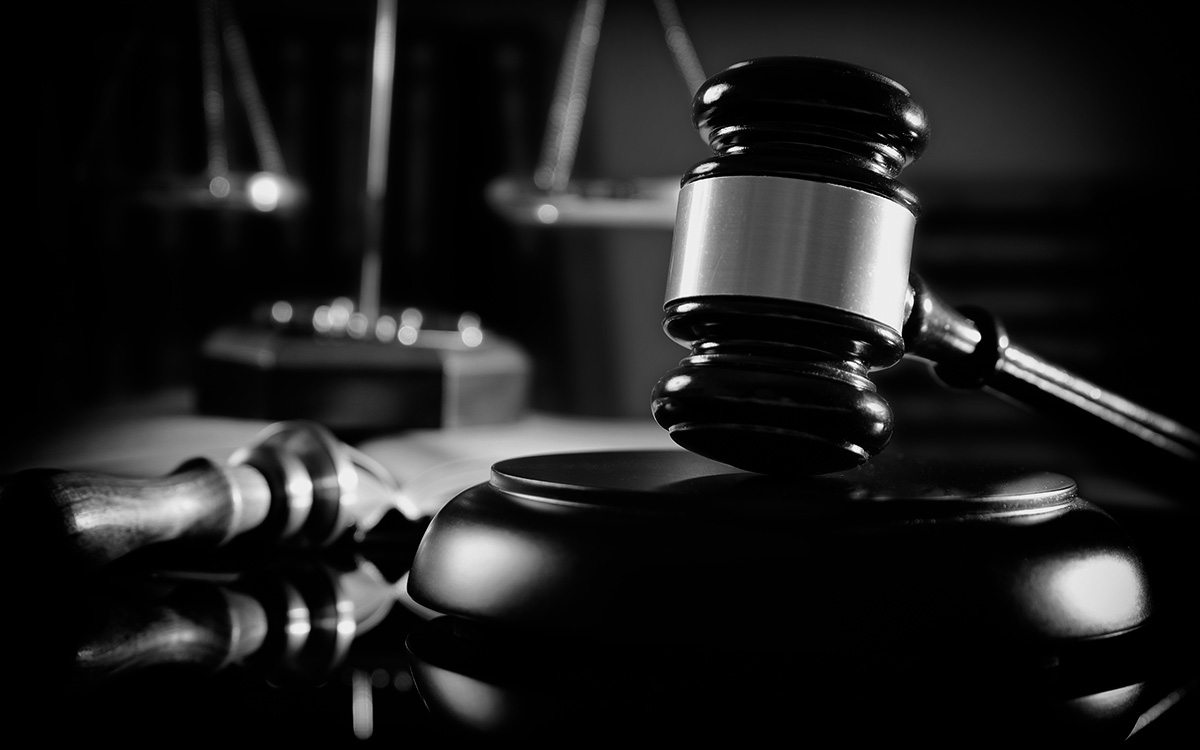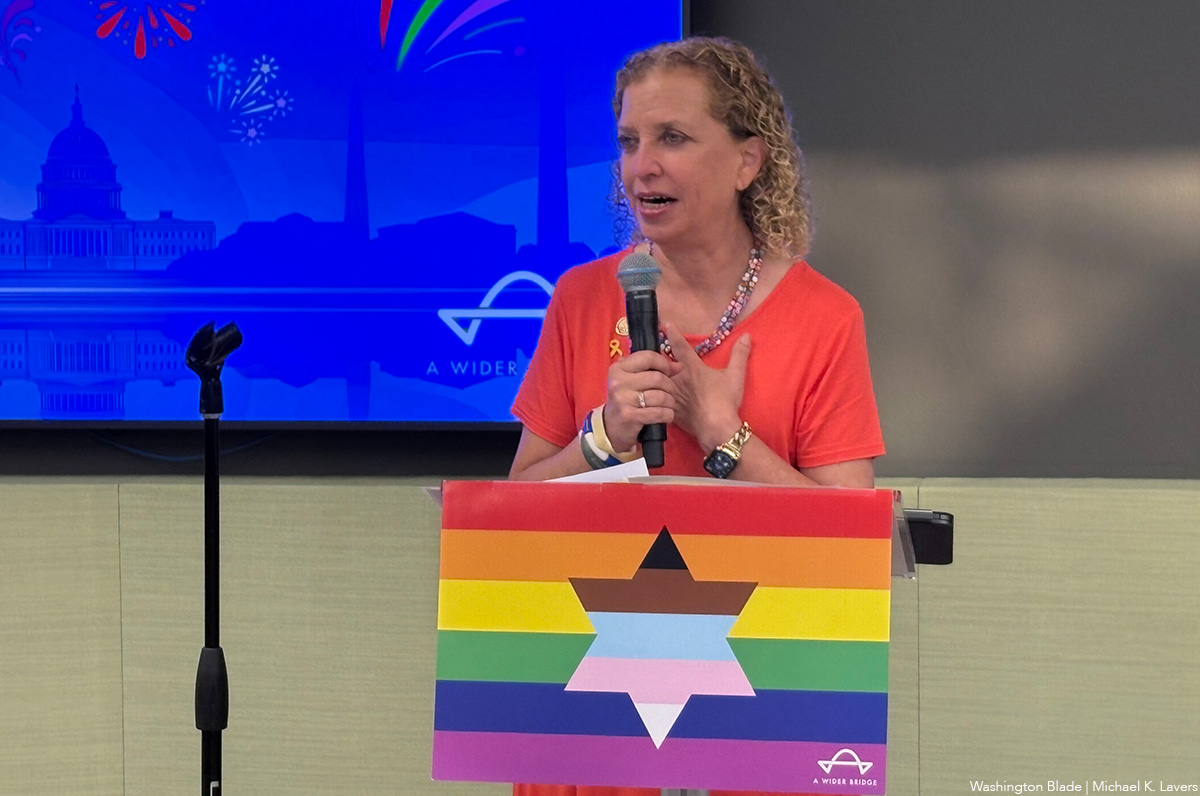National
How data helps — and hurts — LGBTQ communities
‘Even when we prove we exist, we don’t get the resources we need’

When Scotland voted to add questions about sexuality and transgender status to its census, and clarified the definition of “sex,” it was so controversial it led to a court case.
It got so heated that the director of Fair Play for Women, a gender-critical organization, argued: “Extreme gender ideology is deeply embedded within the Scottish Government, and promoted at the highest levels including the First Minister.”
Data, like the census, “is often presented as being objective, being quantitative, being something that’s above politics,” says Kevin Guyan, author of “Queer Data.”
Listening to the deliberations in parliament breaks that illusion entirely. “There’s a lot of political power at play here,” says Guyan, “It’s very much shaped by who’s in the room making these decisions.”
Great Britain has been a ‘hotspot’ for the gender-critical movement. “You just really revealed the politics of what was happening at the time, particularly in association with an expanded anti-trans movement,” explains Guyan.
Ultimately, the LGBTQ community was counted in Scotland, which was heralded as a historic win.
This makes sense, says Amelia Dogan, a research affiliate in the Data plus Feminism Lab at MIT. “People want to prove that we exist.”
Plus, there are practical reasons. “To convince people with power, especially resource allocation power, you need to have data,” says Catherine D’Ignazio, MIT professor and co-author of the book “Data Feminism.”
When data isn’t collected, problems can be ignored. In short, D’Ignazio says, “What’s counted counts.” But, being counted is neither neutral nor a silver bullet. “Even when we do prove we exist, we don’t get the resources that we need,” says Dogan.
“There are a lot of reasons for not wanting to be counted. Counting is not always a good thing” they say. D’Ignazio points to how data has repeatedly been weaponized. “The U.S. literally used census data to intern Japanese people in the 1940s.”
Nell Gaither, president of the Trans Pride Initiative, faces that paradox each day as she gathers and shares data about incarcerated LGBTQ people in Texas.
“Data can be harmful in some ways or used in a harmful way,” she says, “they can use [the data] against us too.” She points to those using numbers of incarcerated transgender people to stoke fears around the danger of trans women, even though it’s trans women who face disproportionate risk in prison.
This is one of the many wrinkles the LGBTQ community and other minority communities face when working with or being represented by data.
There is a belief by some data scientists that limited knowledge of the subject is OK. D’Ignazio describes this as the “hubris of data science” where researchers believe they can make conclusions solely off a data set, regardless of background knowledge or previous bodies of knowledge.
“In order to be able to read the output of a data analysis process, you need background knowledge,” D’Ignazio emphasizes.
Community members, on the other hand, are often primed to interpret data about their communities. “That proximity gives us a shared vocabulary,” explains Nikki Stevens, a postdoctoral researcher in D’Ignazio’s Data plus Feminism lab.
It can also make more rich data. When Stevens was interviewing other members of the transgender community about Transgender Day of Remembrance, they realized we “think more complicated and more meaningful thoughts, because we’re in community around it.”
Community members are also primed to know what to even begin to look for.
A community may know about a widely known problem or need in their community, but they are invisible to institutions. “It’s like unknown to them because they haven’t cared to look,” says D’Ignazio.
That is how Gaither got involved in tracking data about incarcerated LGBTQ people in Texas in the first place.
Gaither received her first letter from an incarcerated person in 2013. As president of the Trans Pride Initiative, Gaither had predominately focused on housing and healthcare for trans people. The pivot to supporting the LGBTQ incarcerated community came out of need—trans prisoners were not given access to constitutionally mandated healthcare.
Gaither sought a legal organization to help, but no one stepped in—they didn’t have expertise. So, Gaither figured it out herself.
As TPI continued to support incarcerated, queer Texans, the letters kept rolling in. Gaither quickly realized her correspondences told a story: definable instances of assault, misconduct, or abuse.
With permission from those she corresponded with and help from volunteers, Gaither started tracking it. “We’re hearing from people reporting violence to us,” says Gaither, “we ought to log these.” TPI also tracks demographic information alongside instances of abuse and violence, all of which are publicly accessible.
“It started off as just a spreadsheet, and then it eventually grew over the years into a database,” says Gaither, who constructed the MySQL database for the project.
Gaither’s work especially focuses on the Prison Rape Elimination Act (PREA), which ostensibly includes specific protections for transgender people.
To be compliant with PREA, prisons must be audited once every three years. Numerous investigations have shown that these audits are often not effective. TPI has filed numerous complaints with the PREA Resource Center, demonstrating inaccuracies or bias, in addition to tracking thousands of PREA-related incidents.
“We are trying to use our data to show the audits are ineffective,” says Gaither.
Gaither has been thinking about data since she was a teenager. She describes using a computer for the first time in the 1970s and being bored with everything except for dBASE, one of the first database management systems.
“Ever since then, I’ve been fascinated with how you can use data and databases to understand what your work with data,” Gaither says. She went on to get a master’s in Library and Information Sciences and built Resource Center Dallas’s client database for transgender health.
But gathering, let alone analyzing, and disseminating data about queer people imprisoned in Texas has proven a challenge.
Some participants fear retaliation for sharing their experiences, while others face health problems that make pinpointing exact dates or times of assaults difficult.
And, despite being cited by The National PREA Resource Center and Human Rights Clinic at the University of Texas School of Law, Gaither still faces those who think her data “doesn’t seem to have as much legitimacy.”
Stevens lauds Gaither’s data collection methods. “TPI collect their data totally consensually. They write to them first and then turn that data into data legible to the state and in the service of community care.”
This is a stark contrast to the current status quo of data collection, says Dogan, “people, and all of our data, regardless of who you are, is getting scraped.” Data scraping refers to when information is imported from websites – like personal social media pages – and used as data.
AI has accelerated this, says D’Ignazio, “it’s like a massive vacuum cleaning of data across the entire internet. It’s this whole new level and scale of non-consensual technology.”
Gaither’s method of building relationships and direct correspondence is a far cry from data scraping. Volunteers read, respond to, and input information from every letter.
Gaither has become close to some of the people with whom she’s corresponded. Referring to a letter she received in 2013, Gaither says: “I still write to her. We’ve known each other for a long time. I consider her to be my friend.”
Her data is queer not simply in its content, but in how she chooses to keep the queer community centered in the process. “I feel very close to her so that makes the data more meaningful. It has a human component behind it,” says Gaither.
Guyan says that data can be seen as a “currency” since it has power. But he emphasizes that “people’s lives are messy, they’re complicated, they’re nuanced, they’re caveated, and a data exercise that relies on only ones and zeros can’t necessarily capture the full complexity and diversity of these lives.”
While Gaither tallies and sorts the incidents of violence, so it is legible as this “currency,” she also grapples with the nuance of the situations behind the scenes. “It’s my family that I’m working with. I think it makes it more significant from a personal level,” says Gaither.
Guyan explains that queer data is not just about the content, but the methods. “You can adopt a queer lens in terms of thinking critically about the method you use when collecting, analyzing, and presenting all types of data.”
(This story is part of the Digital Equity Local Voices Fellowship lab through News is Out. The lab initiative is made possible with support from Comcast NBCUniversal.)
Federal Government
Holiday week brings setbacks for Trump-Vance trans agenda
Federal courts begin to deliver end-of-year responses to lawsuits involving federal transgender healthcare policy.

While many Americans took the week of Christmas to rest and relax, LGBTQ politics in the U.S. continued to shift. This week’s short recap of federal updates highlights two major blows to the Trump-Vance administration’s efforts to restrict gender-affirming care for minors.
19 states sue RFK Jr. to end gender-affirming care ban
New York Attorney General Letitia James announced on Tuesday that the NYAG’s office, along with 18 other states (and the District of Columbia), filed a lawsuit to stop U.S. Health and Human Services (HHS) Secretary Robert F. Kennedy Jr. from restricting gender-affirming care for minors.
In the press release, Attorney General James stressed that the push by the Trump-Vance administration’s crusade against the transgender community — specifically transgender youth — is a “clear overreach by the federal government” and relies on conservative and medically unvalidated practices to “punish providers who adhere to well-established, evidence-based care” that support gender-affirming care.
“At the core of this so-called declaration are real people: young people who need care, parents trying to support their children, and doctors who are simply following the best medical evidence available,” said Attorney General James. “Secretary Kennedy cannot unilaterally change medical standards by posting a document online, and no one should lose access to medically necessary health care because their federal government tried to interfere in decisions that belong in doctors’ offices. My office will always stand up for New Yorkers’ health, dignity, and right to make medical decisions free from intimidation.”
The lawsuit is a direct response to HHS’ Dec. 18 announcement that it will pursue regulatory changes that would make gender-affirming health care for transgender children more difficult, if not impossible, to access. It would also restrict federal funding for any hospital that does not comply with the directive. KFF, an independent source for health policy research, polling, and journalism, found that in 2023 federal funding covered nearly 45% of total spending on hospital care in the U.S.
The HHS directive stems directly from President Donald Trump’s Jan. 28 Executive Order, Protecting Children From Chemical and Surgical Mutilation, which formally establishes U.S. opposition to gender-affirming care and pledges to end federal funding for such treatments.
The American Medical Association, the nation’s largest and most influential physician organization, has repeatedly opposed measures like the one pushed by President Trump’s administration that restrict access to trans health care.
“The AMA supports public and private health insurance coverage for treatment of gender dysphoria and opposes the denial of health insurance based on sexual orientation or gender identity,” a statement on the AMA’s website reads. “Improving access to gender-affirming care is an important means of improving health outcomes for the transgender population.”
The lawsuit also names Oregon, Washington, California, Colorado, Connecticut, Delaware, the District of Columbia, Illinois, Maine, Maryland, Massachusetts, Michigan, Minnesota, New Mexico, Pennsylvania, Rhode Island, Vermont, and Wisconsin as having joined New York in the push against restricting gender-affirming care.
At the HHS news conference last Thursday, Jim O’Neill, deputy secretary of the department, asserted, “Men are men. Men can never become women. Women are women. Women can never become men.”
DOJ stopped from gaining health care records of trans youth
U.S. District Judge Cathy Bissoon blocked an attempt by the Department of Justice (DOJ) to gain “personally identifiable information about those minor transgender patients” from the University of Pittsburgh Medical Center (UPMC), saying the DOJ’s efforts “fly in the face of the Supreme Court.”
Journalist Chris Geidner originally reported the news on Dec. 25, highlighting that the Western District of Pennsylvania judge’s decision is a major blow to the Trump-Vance administration’s agenda to curtail transgender rights.
“[T]his Court joins the others in finding that the government’s demand for deeply private and personal patient information carries more than a whiff of ill intent,” Bissoon wrote in her ruling. “This is apparent from its rhetoric.”
Bissoon cited the DOJ’s “incendiary characterization” of trans youth care on the DOJ website as proof, which calls the practice politically motivated rather than medically sound and seeks to “…mutilate children in the service of a warped ideology.” This is despite the fact that a majority of gender-affirming care has nothing to do with surgery.
In United States v. Skrmetti, the Supreme Court ruled along party lines that states — namely Tennessee — have the right to pass legislation that can prohibit certain medical treatments for transgender minors, saying the law is not subject to heightened scrutiny under the Equal Protection Clause of the Fourteenth Amendment because it does not involve suspect categories like race, national origin, alienage, and religion, which would require the government to show the law serves a compelling interest and is narrowly tailored, sending decision-making power back to the states.
“The government cannot pick and choose the aspects of Skrmetti to honor, and which to ignore,” Judge Bissoon added.
The government argued unsuccessfully that the parents of the children whose records would have been made available to the DOJ “lacked standing” because the subpoena was directed at UPMC and that they did not respond in a timely manner. Bissoon rejected the timeliness argument in particular as “disingenuous.”
Bissoon, who was nominated to the bench by then-President Obama, is at least the fourth judge to reject the DOJ’s attempted intrusion into the health care of trans youth according to Geidner.

A Wider Bridge on Friday announced it will shut down at the end of the month.
The group that “mobilizes the LGBTQ community to fight antisemitism and support Israel and its LGBTQ community” in a letter to supporters said financial challenges prompted the decision.
“After 15 years of building bridges between LGBTQ communities in North America and Israel, A Wider Bridge has made the difficult decision to wind down operations as of Dec. 31, 2025,” it reads.
“This decision comes after challenging financial realities despite our best efforts to secure sustainable funding. We deeply appreciate our supporters and partners who made this work possible.”
Arthur Slepian founded A Wider Bridge in 2010.
The organization in 2016 organized a reception at the National LGBTQ Task Force’s Creating Change Conference in Chicago that was to have featured to Israeli activists. More than 200 people who protested against A Wider Bridge forced the event’s cancellation.
A Wider Bridge in 2024 urged the Capital Pride Alliance and other Pride organizers to ensure Jewish people can safely participate in their events in response to an increase in antisemitic attacks after Hamas militants attacked Israel on Oct. 7, 2023.
The Jewish Telegraphic Agency reported authorities in Vermont late last year charged Ethan Felson, who was A Wider Bridge’s then-executive director, with lewd and lascivious conduct after alleged sexual misconduct against a museum employee. Rabbi Denise Eger succeeded Felson as A Wider Bridge’s interim executive director.
A Wider Bridge in June honored U.S. Rep. Debbie Wasserman Schultz (D-Fla.) at its Pride event that took place at the Capital Jewish Museum in D.C. The event took place 15 days after a gunman killed two Israeli Embassy employees — Yaron Lischinsky and Sarah Milgrim — as they were leaving an event at the museum.
“Though we are winding down, this is not a time to back down. We recognize the deep importance of our mission and work amid attacks on Jewish people and LGBTQ people – and LGBTQ Jews at the intersection,” said A Wider Bridge in its letter. “Our board members remain committed to showing up in their individual capacities to represent queer Jews across diverse spaces — and we know our partners and supporters will continue to do the same.”
Editor’s note: Washington Blade International News Editor Michael K. Lavers traveled to Israel and Palestine with A Wider Bridge in 2016.
The White House
‘Trump Rx’ plan includes sharp cuts to HIV drug prices
President made announcement on Friday

President Donald Trump met with leaders from some of the world’s largest pharmaceutical companies at the White House on Friday to announce his new “Trump Rx” plan and outline efforts to reduce medication costs for Americans.
During the roughly 47-minute meeting in the Roosevelt Room, Trump detailed his administration’s efforts to cut prescription drug prices and make medications more affordable for U.S. patients.
“Starting next year, American drug prices will come down fast, furious, and will soon be among the lowest in the developed world,” Trump said during the meeting. “For decades, Americans have been forced to pay the highest prices in the world for prescription drugs by far … We will get the lowest price of anyone in the world.”
Trump signed an executive order in May directing his administration “to do everything in its power to slash prescription drug prices for Americans while getting other countries to pay more.”
“This represents the greatest victory for patient affordability in the history of American health care, by far, and every single American will benefit,” he added.
Several pharmaceutical executives stood behind the president during the announcement, including Sanofi CEO Paul Hudson, Novartis CEO Vas Narasimhan, Genentech CEO Ashley Magargee, Boehringer Ingelheim (USA) CEO Jean-Michel Boers, Gilead Sciences CEO Dan O’Day, Bristol Myers Squibb General Counsel Cari Gallman, GSK CEO Emma Walmsley, Merck CEO Robert Davis, and Amgen Executive Vice President Peter Griffith.
Also in attendance were Health and Human Services Secretary Robert F. Kennedy Jr., Commerce Secretary Howard Lutnick, Centers for Medicare and Medicaid Services Administrator Mehmet Oz, and Food and Drug Administration Commissioner Marty Makary.
Under the Trump Rx plan, the administration outlined a series of proposed drug price changes across multiple companies and therapeutic areas. Among them were reductions for Amgen’s cholesterol-lowering drug repatha from $573 to $239; Bristol Myers Squibb’s HIV medication reyataz from $1,449 to $217; Boehringer Ingelheim’s type 2 diabetes medication jentadueto from $525 to $55; Genentech’s flu medication xofluza from $168 to $50; and Gilead Sciences’ hepatitis C medication epclusa from $24,920 to $2,425.
Additional reductions included several GSK inhalers — such as the asthma inhaler advair diskus 500/50, from $265 to $89 — Merck’s diabetes medication januvia from $330 to $100, Novartis’ multiple sclerosis medication mayzent from $9,987 to $1,137, and Sanofi’s blood thinner plavix from $756 to $16. Sanofi insulin products would also be capped at $35 per month’s supply.
These prices, however, would only be available to patients who purchase medications directly through TrumpRx. According to the program’s website, TrumpRx “connects patients directly with the best prices, increasing transparency, and cutting out costly third-party markups.”
Kennedy spoke after Trump, thanking the president for efforts to lower pharmaceutical costs in the U.S., where evidence has shown that drug prices — including both brand-name and generic medications — are nearly 2.78 times higher than prices in comparable countries. According to the Pharmaceutical Research and Manufacturers of America, roughly half of every dollar spent on brand-name drugs goes to entities that play no role in their research, development, or manufacturing.
“This is affordability in action,” Kennedy said. “We are reversing that trend and making sure that Americans can afford to get the life-saving solutions.”
Gilead CEO Dan O’Day also spoke about how the restructuring of drug costs under TrumpRx, combined with emerging technologies, could help reduce HIV transmission — a virus that, if untreated, can progress to AIDS. The LGBTQ community remains disproportionately affected by HIV.
“Thank you, Mr. President — you and the administration,” O’Day said. “I think this objective of achieving the commitment to affordability and future innovation is extraordinary … We just recently launched a new medicine that’s only given twice a year to prevent HIV, and we’re working with Secretary Kennedy and his entire team, as well as the State Department, as a part of your strategy to support ending the epidemic during your term.
“I’ve never been more optimistic about the innovation that exists across these companies and the impact this could have on America’s health and economy,” he added.
Trump interjected, asking, “And that’s working well with HIV?”
“Yes,” O’Day replied.
“It’s a big event,” Trump said.
“It literally prevents HIV almost 100 percent given twice a year,” O’Day responded.
A similar anti-HIV medication is currently prescribed more than injectable form mentioned by O’Day. PrEP, is a medication regimen proven to significantly reduce HIV infection rates for people at high risk. Without insurance, brand-name Truvada can cost roughly $2,000 per month, while a generic version costs about $60 per month.
Even when medication prices are reduced, PrEP access carries additional costs, including clinic and laboratory fees, office visits, required HIV and sexually transmitted infection testing, adherence services and counseling, and outreach to potentially eligible patients and providers.
According to a 2022 study, the annual total cost per person for PrEP — including medication and required clinical and laboratory monitoring — is approximately $12,000 to $13,000 per year.
The TrumpRx federal platform website is now live at TrumpRx.gov, but the program is not slated to begin offering reduced drug prices until January.















